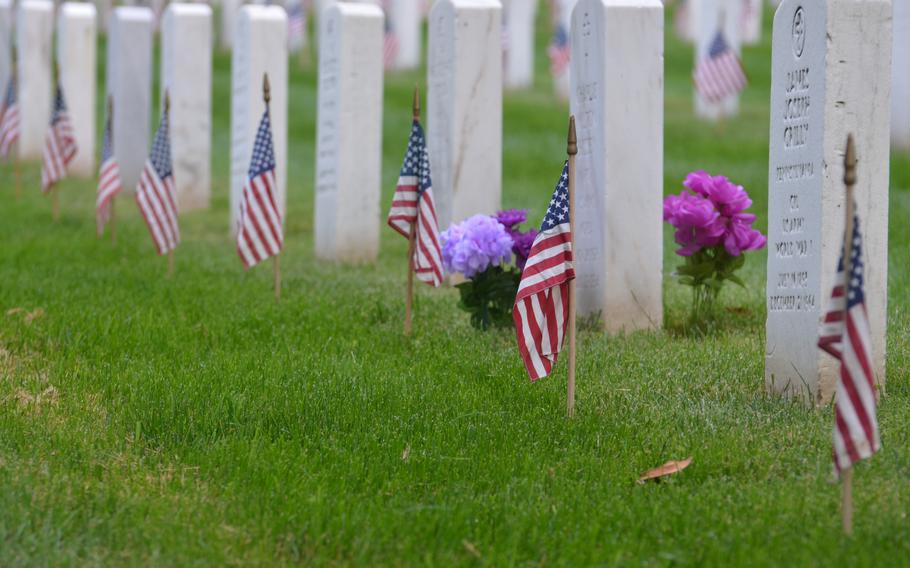
Members of the 3rd Infantry Regiment, also known as The Old Guard, place flags at the graves of those buried at Arlington National Cemetery for “Flags In” on Thursday, May 23, 2024, to honor fallen service members for Memorial Day. (Matthew Adams/Stars and Stripes)
(Tribune News Service) — A bronze rosette has been placed next to the name of a World War II airman from Manchester, N.H., on the Wall of the Missing at the North Africa American Cemetery in Carthage, Tunisia, signifying he has been accounted for, officials with the American Battle Monuments Commission said Thursday.
Joey R. Hood, U.S. Ambassador to the Republic of Tunisia, placed the rosette next to the name of U.S. Army Air Forces 2nd Lt. Stanley J. Samoski.
Samoski, 22, was from Manchester and served with the 334th Bombardment Squadron (Heavy), 98th Bombardment Group (Heavy), 9th Air Force in WWII.
Samoski will be buried at Arlington National Cemetery at a date to be determined, officials said.
The Defense POW/MIA Accounting Agency (DPAA) announced July 2 that remains belonging to Samoski had been positively identified.
On Aug. 1, 1943, a B-24D Liberator (serial number 41-24197) carrying Samoski and nine other crew members took off from an airfield in Lete, Libya, as part of Operation TIDAL WAVE, a large-scale aerial attack against oil refineries in Ploesti, Romania.
The aircraft was last seen over the target area, with its bomb bay on fire, when it suddenly fell behind and out of sight, and eventually crashed. A survivor of the crash later reported that the B-24D took a hit in the nose and top turret sections, caught fire, and was forced to crash-land in a cornfield near the target area.
It hit the ground and rolled at high speed with the crew inside, who were rendered unconscious from the impact.
Five crew members survived and exited the wreckage before it exploded. These men were captured, survived, and eventually were returned to U.S. custody. The other five crew members were not located at the time or heard from following the incident.
Samoski’s remains were not identified following the war. The remains that could not be identified were buried as Unknowns in the Hero Section of the Civilian and Military Cemetery of Bolovan, Ploiești, Prahova, Romania.
Following the war, the American Graves Registration Command (AGRC), an organization responsible for searching for and recovering fallen American personnel, disinterred all American remains from the Bolovan Cemetery for identification.
The AGRC was unable to identify more than 80 unknowns from Bolovan Cemetery, and those remains were permanently interred at Ardennes American Cemetery and Henri-Chapelle American Cemetery, both in Belgium.
In 2017, DPAA began exhuming unknowns believed to be associated with unaccounted-for airmen from Operation TIDAL WAVE losses. These remains were sent to the DPAA Laboratory for examination and identification.
To identify Samoski’s remains, scientists from DPAA used dental and anthropological analysis, along with circumstantial evidence. Scientists from the Armed Forces Medical Examiner System also used mitochondrial DNA (mtDNA) analysis as part of the process.
When a missing service member is recovered, identified and finally laid to rest, the American Battle Monuments Commission (ABMC) places a rosette beside their name on the Walls of the Missing. The rosette, a symbol of eternity, is crafted as a bronze rosemary wreath, encircled by the eight-points of a compass, signifying America’s commitment to reaching out in all directions to recover their remains from the farthest corners of the earth.
Samoski’s rosette is the 21st to be placed on the Wall of the Missing at North Africa American Cemetery, which includes the names of 3,724 service members, and one of more than 900 placed beside the names of missing service members at ABMC sites around the world.
(c)2024 The New Hampshire Union Leader (Manchester, N.H.)
Visit at www.unionleader.com
Distributed by Tribune Content Agency, LLC.